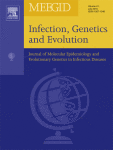Ver ítem
- xmlui.general.dspace_homeCentros e Institutos de InvestigaciónCICVyA. Centro de Investigación en Ciencias Veterinarias y AgronómicasInstituto de BiotecnologíaArtículos científicosxmlui.ArtifactBrowser.ItemViewer.trail
- Inicio
- Centros e Institutos de Investigación
- CICVyA. Centro de Investigación en Ciencias Veterinarias y Agronómicas
- Instituto de Biotecnología
- Artículos científicos
- Ver ítem
Leptospira species molecular epidemiology in the genomic era
Resumen
Leptospirosis is a zoonotic disease which global burden is increasing often related to climatic change. Hundreds of whole genome sequences from worldwide isolates of Leptospira spp. are available nowadays, together with online tools that permit to assign MLST sequence types (STs) directly from raw sequence data. In this work we have applied R7L-MLST to near 500 genomes and strains collection globally distributed. All 10 pathogenic species as well as
[ver mas...]
Leptospirosis is a zoonotic disease which global burden is increasing often related to climatic change. Hundreds of whole genome sequences from worldwide isolates of Leptospira spp. are available nowadays, together with online tools that permit to assign MLST sequence types (STs) directly from raw sequence data. In this work we have applied R7L-MLST to near 500 genomes and strains collection globally distributed. All 10 pathogenic species as well as intermediate were typed using this MLST scheme. The correlation observed between STs and serogroups in our previous work, is still satisfied with this higher dataset sustaining the implementation of MLST to assist serological classification as a complementary approach. Bayesian phylogenetic analysis of concatenated sequences from R7-MLST loci allowed us to resolve taxonomic inconsistencies but also showed that events such as recombination, gene conversion or lateral gene transfer played an important role in the evolution of Leptospira genus. Whole genome sequencing allows us to contribute with suitable epidemiologic information useful to apply in the design of control strategies and also in diagnostic methods for this illness.
[Cerrar]

Fuente
Infection, Genetics and Evolution 54 : 478-485 (Octubre 2017)
Fecha
2017-10
Editorial
Elsevier
ISSN
1567-1348
Formato
pdf
Tipo de documento
artículo
Palabras Claves
Derechos de acceso
Restringido
 Excepto donde se diga explicitamente, este item se publica bajo la siguiente descripción: Creative Commons Attribution-NonCommercial-ShareAlike 2.5 Unported (CC BY-NC-SA 2.5)
Excepto donde se diga explicitamente, este item se publica bajo la siguiente descripción: Creative Commons Attribution-NonCommercial-ShareAlike 2.5 Unported (CC BY-NC-SA 2.5)

